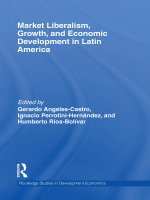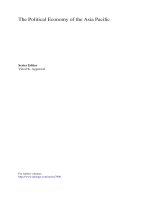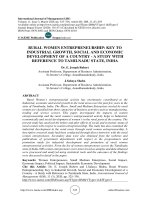Economic growth and economic development 379
Bạn đang xem bản rút gọn của tài liệu. Xem và tải ngay bản đầy đủ của tài liệu tại đây (102.92 KB, 1 trang )
Introduction to Modern Economic Growth
Show that this is only possible if x00 (t) = 0, so that the shortest path between two
points is a straight-line.
Exercise 7.5. Prove Theorem 7.2, in particular, paying attention to constructing
feasible variations that ensure x (t1 , ε) = x1 for all ε in some neighborhood of 0.
What happens if there are no such feasible variations?
Exercise 7.6.
(1) Provide an expression for the initial level of consumption
c (0) as a function of a (0), w, r and β in Example 7.1.
(2) What is the effect of an increase in a (0) on the initial level of consumption
c (0)? What is the effect on the consumption path?
(3) How would the consumption path change if instead of a constant level of
labor earnings, w, the individual faced a time-varying labor income profile
given by [w (t)]1t=0 ? Explain the reasoning for the answer in detail.
Exercise 7.7. Prove Theorem 7.4.
Exercise 7.8. * Prove a version of Theorem 7.5 corresponding to Theorem 7.2.
[Hint: instead of λ (t1 ) = 0, the proof should exploit the fact that x (1) = xˆ (1) = x1 ].
Exercise 7.9. * Prove that in the finite-horizon problem of maximizing (7.1) or
(7.11) subject to (7.2) and (7.3), fx (t, xˆ (t) , yˆ (t) , λ (t)) > 0 for all t ∈ [0, t1 ] implies
that λ (t) > 0 for all t ∈ [0, t1 ].
Exercise 7.10. * Prove Theorem 7.6.
Exercise 7.11. Prove Theorem 7.11.
Exercise 7.12. Provide a proof of Theorem 7.15.
Exercise 7.13. Prove that in the discounted infinite-horizon optimal control problem considered in Theorem 7.14 conditions (7.51)-(7.53) are necessary.
Exercise 7.14. Consider a finite horizon continuous time maximization problem,
where the objective function is
W (x (t) , y (t)) =
Z
t1
f (t, x (t) , y (t)) dt
0
with x (0) = x0 and t1 < ∞, and the constraint equation is
x˙ (t) = g (t, x (t) , y (t)) .
Imagine that t1 is also a choice variable.
365









